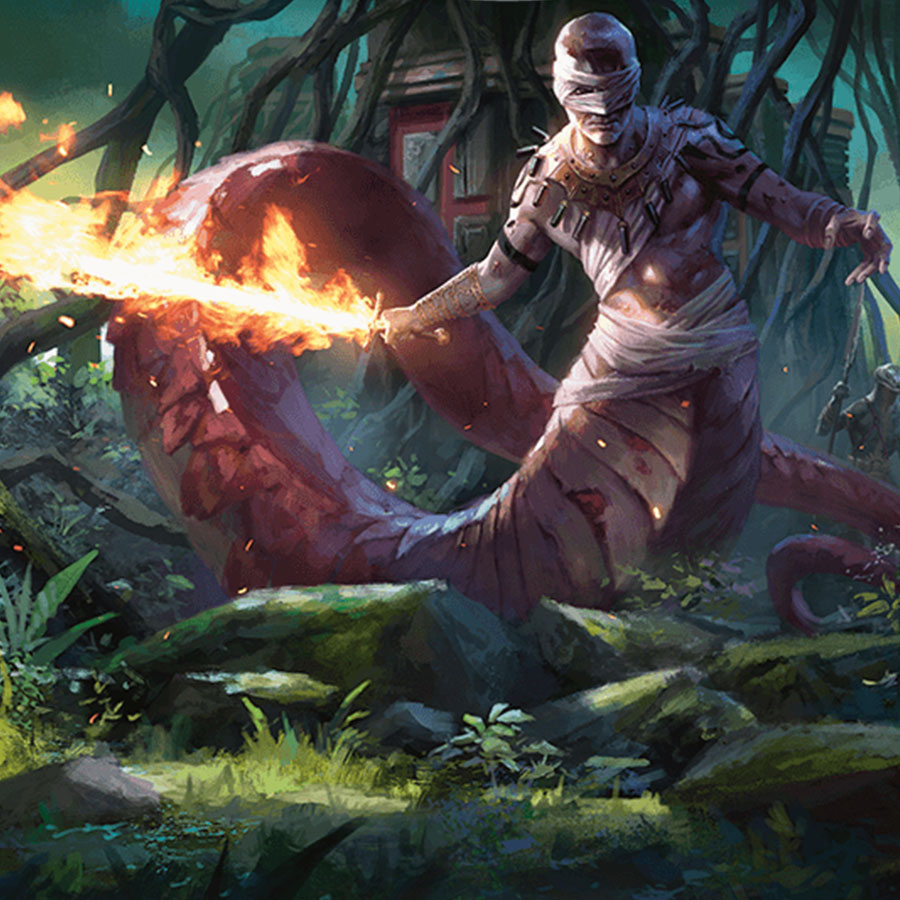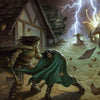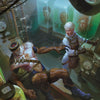How to Create an Event-Based D&D Adventure in 10 Steps

Today we’ll be going over ten steps for creating an EVENT-based adventure. And, in case you’re wondering what an “event” based adventure even is, let me contrast it with a LOCATION-based adventure.
You see, a location-based adventure takes place in one specific place, such as a dungeon or castle, as is by and far the norm for published D&D adventure modules, and I’m guessing for homebrew campaigns, too.
However, an event-based adventure is not tied to any one place in the game world, such as a dungeon or castle. Instead of being defined in part by WHERE the adventure takes place, an event-based adventure is framed by the EVENTS that take place,
Specifically, by what the villain does and what the players’ characters do in response to the villain’s actions. And where those events take place is of secondary importance. Then these events and the characters’ responses to them all tie together to form the meat of the adventure, which will almost assuredly take place in a variety of locations.
The big advantage of running an event-based adventure is that because things are NOT confined to a dungeon or other location, your players will feel like they have much greater freedom with what they can do in the adventure.
Another difference, which is either a pro or con, depending on your point of view, is that event-based adventures can require LESS preparation from the dungeon master before the game, but rely on far more improvisation DURING the game.
Whereas, with LOCATION-based adventures, there is typically far more preparation BEFORE the game and much less DURING the game.
And an interesting point, here, the Dungeon Master Guide actually says the opposite about this, but in my experience, it’s definitely not true. Location-based adventures BY FAR require more preparation than event-based adventures.
By the way, if you’re a new dungeon master feeling a bit OVERWHELMED by everything involved in running a D&D game, I completely understand. Being a DM isn’t always easy, and my personal goal is to help game masters by providing information and resources to make your life easier! That’s why my team and I make all these articles and videos.
However, Lairs & Legends is another such resource. With over 700 pages of adventures, monsters, puzzles, traps, and other 5e GM resources, you can SIGNIFICANTLY reduce your prep time and still run amazing games for your players.
Watch or listen to this article by clicking the video below.
Step 1: Create the Villain
Having a good solid villain is extremely important, even more so than with a location-based adventure, IMO. Without a well-designed villain, you’ll really struggle to run an event-based adventure.
Determine the Villain’s Motivations, Goals, and Minions. The motivation, goal, and minions are important because you’ll be using them constantly as you improvise on the fly while running the adventure.
For example, let’s take a vampire, Sardack the Sinister. Minions: vampire spawn and humanoid followers. Motivation and Goal: Sardack wants to incriminate a goodly vampire in the region, Petreva the Pure, who has been his foe for centuries, and bring about her downfall.
Then create a description of the villain, and create or use an existing stat block for the villain. In our case, we need a basic description of Sardack the Sinister. We will use a vampire’s stat block, but customize it a little, giving him some spell-casting abilities.
Step 2: Create the Storyline or Plot
This is essentially the villain’s plans for achieving their goal.
Sardack the Sinister is planning a crime spree where he kills several victims in the city, draining them of blood, and then planting subtle evidence at each crime scene that points to Petreva the Pure being the culprit.
Consider a “timer” element to the adventure that pressures the PCs to keep moving and not take a long rest after every event/encounter. Remember that D&D 5e game design is built around the “adventuring day” whereby the party becomes depleted of resources over the course of the adventure and is not at full resources when they finally take on the villain. Of course, if you’re using a game system such as Pathfinder 2e, where resource depletion is not needed, your job is far easier.
In our case, Sardack the Sinister kills a new victim every hour, putting pressure on the PCs to solve the problem quickly.
Step 3: Determine the Inciting Action and Party’s Goals
Flesh out how the adventure will be introduced to the characters. Clearly present the problem, a reward for the PCs, and a next step.
Petreva the Pure has been keeping an eye on Sardack the Sinister for centuries and suspects he is behind the murders. However, she can’t risk being seen investigating the crime scenes for risk of implicating herself. So, she or one of her followers approaches the PCs with a request for help, promising them gold or treasure if they find out who is behind the murders, find evidence that points to them, and bring them to justice. She then tells them of a particular crime scene where they can begin their investigations.
The party’s goal is usually built into the inciting action, such as in the example above. They need to have a clear goal, though, otherwise they’ll have not idea what they’re supposed to do.
Step 4: Determine and Flesh Out Key NPCs
You’ll need the names, descriptions, motivations, and secrets for any key NPCs they characters might encounter. Answer questions such as: Do the NPCs help them? Hinder them? How do they fit into the adventure?
For example, a retired old adventurer, Trimbol, is always sticking his nose into affairs of the police, and he’s been poking around the crime scenes, too. The characters observe him a couple times, even.
Step 5: Plan Events That Will Occur in the Adventure
First plan out the events that would occur (and when they would occur) if the characters do NOTHING.
To continue our example, we’ll do the following:
- Plan out several victims that Sardack the Sinister will murder and the evidence he’ll leave at the crime scenes that will point to Petreva the Pure.
- Also plan out the evidence at the crime scenes that point to Sardack the Sinister, because the PCs will need to have a way to follow a trail to him and ultimately discover the truth.
- At one point, our NPC, Trimbol, approaches the characters after having noticed they are investigating the murders. He presents them with some evidence they missed that points to Sardack the Sinister.
- Plan out the villain’s possible reactions to actions the PCs are likely to take.
- Sardack the Sinister is keeping an eye on the crime scenes to be sure the authorities are taking the bait, but when he notices the characters finding evidence that leads to him, he sends some of his humanoid followers to mislead them.
- If that doesn’t work, or when the PCs get back on the trail that points to Sardack, he dispatches some vampire spawn to take the characters out.
- As the characters get closer to discovering that the true murderer is Sardack, the vampire plants more and more obvious evidence that points to Petreva the Pure. He also gets better at cleaning up evidence that points to him.
- Sardack might also bribe a city official who tries to interfere with the characters’ investigations.
Tip: don’t go overboard with planning out events or villain’s reactions. You can’t plan out every possible contingency. If you try, it’s a lot of work, and much of it won’t get used.
You might use flowchart or simple improvise as you go, depending on your level of experience. The more you track toward improvising, the less preparation work you’ll need to do before the game.
Step 6: Plan the Encounters
Using minions of the villain, craft some level-appropriate encounters that you could use against the characters. These might be used as part of the planned events or the villain’s reactions to the character’s actions in the adventure.
In our example, the humanoid followers and the vampire spawn that Sardack the Sinister sends against the characters are examples of encounters you’ll plan for the adventure.
Since you’ll be improvising a lot during event-based adventure, having ready-to-go encounters built in advance will be useful. Then you don’t need to build them on the fly, which can be challenging.
Then when you’re running the adventure, you can pick and choose from the encounters you planned out, using them as needed on the fly depending on what is needed based on character actions and what the villain decides to do in response.
For instance, when the characters find evidence that points to Sardack the Sinister’s lair, he sends a mob of zombies to intercept them. And an incorporeal wraith flies among them, attempting to steal away the evidence gathered thus far.
Event-based adventures are much harder to follow the “adventuring day” mechanics (DMG 84) with. So, since it’s possible/likely that PCs will be at full resources, plan encounters with waves OR hard/deadly encounters.
Having a “timer” element to discourage long resting to the adventure will avoid having to do this, and then you can use the “adventuring day” mechanics. In this case, plan out the proper number of encounters, including the final boss fight, to satisfy the adventuring day mechanics.
In our example, Sardack the Sinister murdering a new victim every hour discourages the party from both short resting (though they probably will still need to a couple times) and especially from long resting.
In fact, a long rest might lead to the city authorities following the evidence to Petreva the Pure and arresting her. Then the pressure is on even more for the characters to clear her name and find the real murderer.
Step 7: Flesh Out Key Locations
Detail out the important locations you either know or THINK might get used in the adventure. This doesn’t need to be as detailed as a location-based adventure that typically fleshes out the details of every single room in a dungeon or castle. You might just need ONE room in the dungeon or castle.
If one of Sardack the Sinister’s victims was found in the sewers and another in a well-appointed bedroom in a manor – well, those are the locations you need to flesh out and add details to. Don’t flesh out the entire sewer system or the entire manor.
If you know an event will take place in a location, detail it out. Then, also have a few extra locations ready that might get used as part of the villain’s reactions, or just in case you need them.
Step 8: Plan a Climax
The climax of an adventure typically includes a confrontation of sorts with the villain. It’s the final big event that happens wherein the characters have the chance to bring the adventure to either a successful or unsuccessful conclusion.
In our example, after overcoming the minions and foils that Sardack the Sinister has sent their way, the characters finally track Sardack down to his chateau on the slopes of the nearby Cloud Mountains.
Sardack cordially invites the characters into his audience hall where he and several of his minions await. Sardack intends to bribe the characters off with wealth and veiled threats, but if that fails, the fight is on and the characters will have defeat him in battle.
For the climax, you REALLY want to flesh out the location and the encounter. Make it really tight and awesome. See my Boss Fight creation article for tips on how to do that.
Step 9: Plan a Resolution
What happens once the characters successfully complete the adventure or fail?
After Sardack the Sinister is defeated and brought to justice (or just plan murdered by the characters), Petreva the Pure presents the characters with their promised reward. Or, if the characters fail, does Sardack continue on his murder spree, or relent, having accomplished his goal?
Step 10: Run the Adventure!
Play out the events (according to a timeline you establish) and then use the villain’s counters and responses to the characters’ actions that you planned out. Also, use the villain’s motivation and goal to determine how they react to the characters’ actions.
Don’t be afraid to improvise as you go. In an event-based adventure more so than a location-based adventure, you’ll probably need to improvise quite a bit. This is why we prepared encounters and locations in advance. Use them!
Over 700 Pages of 5e Resources for Your Game!
When I was a new dungeon master, I was overwhelmed with everything I needed to do. Learn the rules, create the adventures, run the game, handle problem players—it was A LOT! And even as a veteran DM, it’s still a lot. You might even feel that way yourself.
This is exactly why my team and I dedicate our time to producing resources to help our fellow dungeon masters: we know exactly how you sometimes feel!
Now, if you’re stressed out with having to create all the adventures for your 5e game, or you’re looking for elements such as traps, puzzles, and encounters that you can drag and drop into your game, we have you covered. With Lairs & Legends and Loot & Lore, you’ll get over 700 pages of 5e resources:
- Twenty-nine 5e adventures spanning levels 1 to 15 and designed for groups of 4 to 6 players.
- Over 100 new creatures from CR 0 to CR 24.
- Adventure Ideas
- Encounters with Full-Color and Blackline Digital Maps
- Patrons & Factions
- Magic Items
- NPCs
- Puzzles
- Random Encounter Tables
- Random Tables
- Spells
- Subclasses
- Traps
- Villains
Everything is designed to be EASY TO USE and QUICK TO PREP for your game. Our goal is to make game masters’ lives easier, not more complex!
Don’t spend another moment frustrated and overwhelmed as a DM. Pick up the Lairs & Legends Ultimate Bundle today and find out how much easier being a DM can be!
-
Posted in
Game Master How-To Articles







